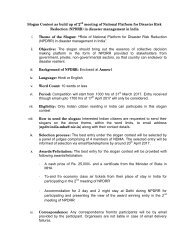National Disaster Management Guidelines School Safety Policy
School-Safety-Policy
School-Safety-Policy
Create successful ePaper yourself
Turn your PDF publications into a flip-book with our unique Google optimized e-Paper software.
SCHOOL <strong>Safety</strong><br />
POLICY <strong>Guidelines</strong><br />
Section 3<br />
The <strong>School</strong> <strong>Management</strong> Committee needs<br />
to be trained on assessment of safety needs,<br />
developing plans as well as safety audit which<br />
needs to be conducted quarterly. This includes<br />
checks to ensure that facilities and resources<br />
within the school are maintained viz. safe water<br />
and sanitation, first aid kits, fire extinguishers etc.<br />
<strong>Disaster</strong> <strong>Management</strong> in Core Curriculum<br />
Dedicated actions for building the capacity of<br />
students and staff in schools are needed to create<br />
a “culture of safety” within the larger community<br />
to which the students and teachers belong. This<br />
“culture of safety” would be an outcome of the<br />
collective efforts of the educational institutional<br />
machinery with other institutions concerned<br />
with disaster risk such as the State and District<br />
<strong>Disaster</strong> <strong>Management</strong> Authorities.<br />
On their part, Central Board of Secondary<br />
Education, State Boards of Secondary Education<br />
(SCERT), and other institutions involved in<br />
curriculum development need to include age<br />
appropriate theoretical as well as practical<br />
knowledge on risk of disasters, nationally and<br />
specifically about their own state.<br />
Practical training on health promotion and disease<br />
prevention concepts and health-enhancing<br />
behaviors and life skills is important.<br />
List of Trainings required for promotion of<br />
school safety is available in Annexure 3<br />
Peer Education and Use of Child Friendly<br />
Methods<br />
The strategy of peer–to-peer education is a<br />
tested strategy for imparting specific knowledge<br />
on disasters such that it reaches each and every<br />
student within the school.<br />
This strategy not only promises extended<br />
outreach, it also facilitates the development<br />
of leadership skills in the students at school<br />
and within their community. Peer education<br />
for disaster management may be extended to<br />
peer mediation in cases of bullying or any other<br />
incidences of violence that can be resolved by<br />
students themselves.<br />
It is also important to ensure that appropriate<br />
child friendly techniques are used in the process<br />
of skill building. Use of songs, skits, puppet<br />
shows, drawing competitions, quiz competitions,<br />
essay/ slogan writing and demonstration are<br />
proven ways of transferring knowledge and<br />
skills to children.<br />
3.5 Regular monitoring of risk and<br />
revision of plan<br />
Implementation of <strong>National</strong> <strong>School</strong> <strong>Safety</strong> <strong>Policy</strong><br />
<strong>Guidelines</strong> needs to be monitored at the national<br />
level jointly by MHRD and NDMA. At the state<br />
level, implementation of the <strong>Guidelines</strong> needs<br />
to be monitored by State Education Department<br />
and SDMA.<br />
SSA Framework offers broad guidelines on<br />
provisioning of <strong>School</strong> Infrastructure facilities.<br />
Therefore, suitable indicators to monitor disaster<br />
risk to children may be developed/monitored by<br />
the State Governments based on their specific<br />
conditions in assistance with SDMAs.<br />
The education machinery at State/district level<br />
needs to strengthen their efforts at promoting<br />
school safety for aided as well as private schools.<br />
The District Education Officer must ensure that<br />
‘Recognition Certificate’ under sub-rule (4) 15<br />
of Right of Children to Free and Compulsory<br />
Education Rules, 2010 is issued only to those<br />
schools that comply with safety norms laid out<br />
in the Building Codes. This compliance needs to<br />
be monitored on a regular basis. In addition, a<br />
mechanism needs to be evolved by the District<br />
Education Officer and any other Regulatory<br />
Authorities for monitoring safety parameters<br />
in all schools on a regular basis. Any existing<br />
monitoring formats being used by the Authorities<br />
shall essentially include parameters on school<br />
safety.<br />
In addition, each district should designate the<br />
Block Education Officer or any other official as<br />
appropriate, for overseeing and facilitating school<br />
safety at the block level.<br />
To ensure that schools remain ‘safe’ for the<br />
students and the teachers, it is important that<br />
the <strong>School</strong> Development Plans are reviewed<br />
and updated regularly by <strong>School</strong> <strong>Management</strong><br />
Committee on a quarterly basis. There could be<br />
cases of unaddressed hazards and additional<br />
new hazards that emerge in the course of the<br />
implementation of the <strong>School</strong> Development<br />
Plan. These will be integrated into the <strong>School</strong><br />
Development Plan through the process of<br />
review and up-dation. In addition, there may be<br />
risks that have to be monitored periodically to<br />
safeguard the health and well-being of children,<br />
such as cleanliness of toilets and quality of<br />
drinking water.<br />
18



